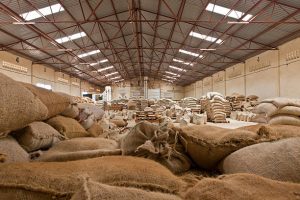Have you ever wondered what it takes to get coffee from the farm to your kitchen? Turns out, quite a bit.
In Coffee Producing Countries
We’ve already learned about how coffee grows and the harvesting process. We’ve also learned about different processing methods, and how that affects the flavor of coffee. Depending on the farm, they may process the coffee on site. Otherwise, smaller farms send the coffee to a mill or processing co-op. When small farms send coffee out for processing, the mills often combine it with coffees from other small producers. If you pick up a bag that says “co-op”, there’s a good chance it is a cooperative effort from several small farms in the same region.
Once coffee processing is complete, the coffee is ready for sale. Some coffee roasters have a partnership with a specific farm or co-op and choose to buy the coffee directly from them. This is one way that coffee can be direct trade. Otherwise, some coffee importers choose to partner with a few different farms or co-ops to facilitate coffee sales with roasters. This is another form of direct trade. One of our favorites to work with is Cafe Kreyol, who, through their partnerships with farmers, is able to pay farmers up to 300% the rate that fair trade requires. You can shop our direct trade coffees here.
In other cases, regional coffee sellers export the coffee to wholesalers. For example, a seller in Costa Rica would buy the coffee from farms and mills in Costa Rica, and then resell that coffee to importers outside Costa Rica. Usually, the regional sellers set the prices of coffee, rather than the farmers. This is why fair trade coffee is important, to make sure that farmers are paid a sustainable amount.
In Coffee Buying Countries
After sellers export the coffee, it gets loaded onto container ships and sent to the importing country. Coffee importers buy the coffee and then sell it to roasters in their country. Many importers prioritize knowing the farm from which the coffee came. This means the coffee is traceable. Not all coffee is traceable, especially when the mill combines it with other coffee from the same region. And even with traceable coffee, there is not always a guarantee that the farmers are paid well because the exporter sets the price.
Importers have warehouses in various parts of the country, and send the coffee to those warehouses until they sell it. It’s common in the US to have a warehouse on the east coast, west coast, and gulf coast, with different container ships headed to each port. In larger countries, it’s also common to have warehouses where various importers send their coffee until it is sold.
When roasters buy the coffee, importers will either ship it directly to the roaster or allow the roaster to pick up from the warehouse. Here in the Portland area, we work with Costa Oro. Importers will send their coffee to Costa Oro for storage, and when we are ready to buy coffee, we will ask the importer what they have available at Costa Oro, and then ask them to release the coffee to us. Then we pick up the coffee and roast it for you!
Coffee travels a lot of miles to get to you, and there are a lot of hands involved in that work. We’re grateful for our partners and especially for those who are making the industry more sustainable for farmers.

